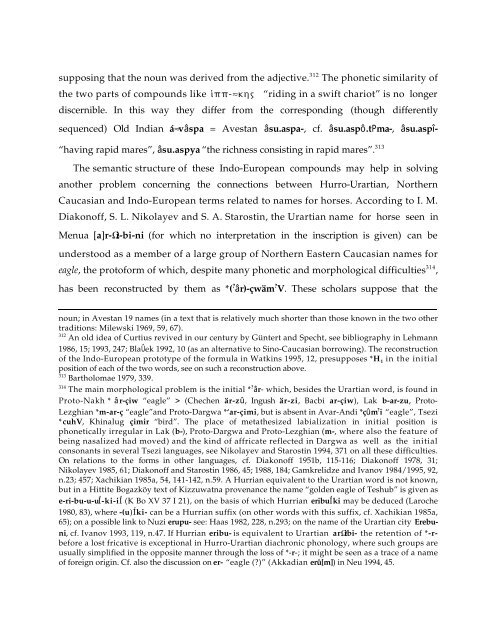Comparative Notes on Hurro-Urartian, Northern Caucasian
Comparative Notes on Hurro-Urartian, Northern Caucasian
Comparative Notes on Hurro-Urartian, Northern Caucasian
Create successful ePaper yourself
Turn your PDF publications into a flip-book with our unique Google optimized e-Paper software.
supposing that the noun was derived from the adjective. 312 The ph<strong>on</strong>etic similarity of<br />
the two parts of compounds like flpp-≈khw “riding in a swift chariot” is no l<strong>on</strong>ger<br />
discernible. In this way they differ from the corresp<strong>on</strong>ding (though differently<br />
sequenced) Old Indian á≈vâspa = Avestan âsu.aspa-, cf. âsu.aspô.tPma-, âsu.aspî-<br />
“having rapid mares”, âsu.aspya “the richness c<strong>on</strong>sisting in rapid mares”. 313<br />
The semantic structure of these Indo-European compounds may help in solving<br />
another problem c<strong>on</strong>cerning the c<strong>on</strong>necti<strong>on</strong>s between <strong>Hurro</strong>-<strong>Urartian</strong>, <strong>Northern</strong><br />
<strong>Caucasian</strong> and Indo-European terms related to names for horses. According to I. M.<br />
Diak<strong>on</strong>off, S. L. Nikolayev and S. A. Starostin, the <strong>Urartian</strong> name for horse seen in<br />
Menua [a]r-Ωi-bi-ni (for which no interpretati<strong>on</strong> in the inscripti<strong>on</strong> is given) can be<br />
understood as a member of a large group of <strong>Northern</strong> Eastern <strong>Caucasian</strong> names for<br />
eagle, the protoform of which, despite many ph<strong>on</strong>etic and morphological difficulties 314 ,<br />
has been rec<strong>on</strong>structed by them as *( ? âr)-çwäm ? V. These scholars suppose that the<br />
noun; in Avestan 19 names (in a text that is relatively much shorter than those known in the two other<br />
traditi<strong>on</strong>s: Milewski 1969, 59, 67).<br />
312 An old idea of Curtius revived in our century by Güntert and Specht, see bibliography in Lehmann<br />
1986, 15; 1993, 247; BlaÛek 1992, 10 (as an alternative to Sino-<strong>Caucasian</strong> borrowing). The rec<strong>on</strong>structi<strong>on</strong><br />
of the Indo-European prototype of the formula in Watkins 1995, 12, presupposes *H 1 in the initial<br />
positi<strong>on</strong> of each of the two words, see <strong>on</strong> such a rec<strong>on</strong>structi<strong>on</strong> above.<br />
313 Bartholomae 1979, 339.<br />
314 The main morphological problem is the initial * ? âr- which, besides the <strong>Urartian</strong> word, is found in<br />
Proto-Nakh * âr-çiw “eagle” > (Chechen är-zû, Ingush är-zi, Bacbi ar-çiw), Lak b-ar-zu, Proto-<br />
Lezghian *m-ar-ç “eagle”and Proto-Dargwa *‘ar-çimi, but is absent in Avar-Andi *çûm ? i “eagle”, Tsezi<br />
*cuhV, Khinalug çimir “bird”. The place of metathesized labializati<strong>on</strong> in initial positi<strong>on</strong> is<br />
ph<strong>on</strong>etically irregular in Lak (b-), Proto-Dargwa and Proto-Lezghian (m-, where also the feature of<br />
being nasalized had moved) and the kind of affricate reflected in Dargwa as well as the initial<br />
c<strong>on</strong>s<strong>on</strong>ants in several Tsezi languages, see Nikolayev and Starostin 1994, 371 <strong>on</strong> all these difficulties.<br />
On relati<strong>on</strong>s to the forms in other languages, cf. Diak<strong>on</strong>off 1951b, 115-116; Diak<strong>on</strong>off 1978, 31;<br />
Nikolayev 1985, 61; Diak<strong>on</strong>off and Starostin 1986, 45; 1988, 184; Gamkrelidze and Ivanov 1984/1995, 92,<br />
n.23; 457; Xachikian 1985a, 54, 141-142, n.59. A Hurrian equivalent to the <strong>Urartian</strong> word is not known,<br />
but in a Hittite Bo azköy text of Kizzuwatna provenance the name “golden eagle of Teshub” is given as<br />
e-ri-bu-u-uÍ-ki-iÍ (K Bo XV 37 I 21), <strong>on</strong> the basis of which Hurrian eribuÍki may be deduced (Laroche<br />
1980, 83), where -(u)Íki- can be a Hurrian suffix (<strong>on</strong> other words with this suffix, cf. Xachikian 1985a,<br />
65); <strong>on</strong> a possible link to Nuzi erupu- see: Haas 1982, 228, n.293; <strong>on</strong> the name of the <strong>Urartian</strong> city Erebuni,<br />
cf. Ivanov 1993, 119, n.47. If Hurrian eribu- is equivalent to <strong>Urartian</strong> arΩibi- the retenti<strong>on</strong> of *-rbefore<br />
a lost fricative is excepti<strong>on</strong>al in <strong>Hurro</strong>-<strong>Urartian</strong> diachr<strong>on</strong>ic ph<strong>on</strong>ology, where such groups are<br />
usually simplified in the opposite manner through the loss of *-r-; it might be seen as a trace of a name<br />
of foreign origin. Cf. also the discussi<strong>on</strong> <strong>on</strong> er- “eagle (?)” (Akkadian erû[m]) in Neu 1994, 45.





